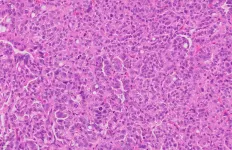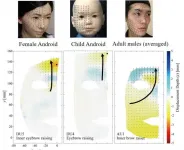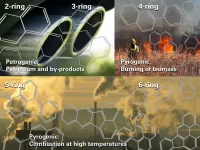INFORMATION:
Also participating in this research were, from the Weizmann Institute of Science: Dr. Deborah Nejman, Dr. Michal Alon, Chaya Barbolin, Dr. Ronen Levy, Sophie Trabish, Dr. Leore Geller, Polina Greenberg, Gal Yagel, Dr. Aviyah Peri and Lior Roitman from Molecular Cell Biology Department; Yuval Bussi, Dr. Adina Weinberger, Maya Lotan-Pompan and Prof. Eran Segal from Computer Science and Applied Mathematics Department and Molecular Cell Biology Department; Dr. Ron Rotkopf and Ofra Golani from Life Sciences Core Facilities Department; Dr. Tali Dadosh and Dr. Smadar Levin-Zaidman from Chemical Research Support Department; Dr. Garold Fuks from Physics of Complex Systems Department; and Dr. Raya Eilam from Veterinary Resources Department.
Prof. Yardena Samuels's research is supported by the EKARD Institute for Cancer Diagnosis Research; the Weizmann-Brazil Tumor Bank; the Moross Integrated Cancer Center; the Laboratory in the name of M.E.H Fund established by Margot and Ernst Hamburger; the Green Family Charitable Foundation; the Wagner-Braunsberg Family Melanoma Research Fund; the Jean-Jacques Brunschwig Fund for the Molecular Genetics of Cancer; the Erica Drake Fund; Miel de Botton; the Rising Tide Foundation; the Fundación Ramón Areces; the Hanna and Dr. Ludwik Wallach Cancer Research Fund; the Jacques Asseoff Trust; the estate of Adrian Finer; the retate of Mady Dukler; Karl-Johan Persson; and the estate of Malka Moskowitz. Prof. Samuels is the incumbent of the Knell Family Professorial Chair.
Bacteria may aid anti-cancer immune response
The findings of a new study may explain the microbiome-immunotherapy connection
2021-03-22
(Press-News.org) Cancer immunotherapy may get a boost from an unexpected direction: bacteria residing within tumor cells. In a new study published in Nature, researchers at the Weizmann Institute of Science and their collaborators have discovered that the immune system "sees" these bacteria and shown they can be harnessed to provoke an immune reaction against the tumor. The study may also help clarify the connection between immunotherapy and the gut microbiome, explaining the findings of previous research that the microbiome affects the success of immunotherapy.
Immunotherapy treatments of the past decade or so have dramatically improved recovery rates from certain cancers, particularly malignant melanoma; but in melanoma, they still work in only about 40% of the cases. Prof. Yardena Samuels of Weizmann's Molecular Cell Biology Department studies molecular "signposts" - protein fragments, or peptides, on the cell surface - that mark cancer cells as foreign and may therefore serve as potential added targets for immunotherapy. In the new study, she and colleagues extended their search for new cancer signposts to those bacteria known to colonize tumors.
Using methods developed by departmental colleague Dr. Ravid Straussman, who was one of the first to reveal the nature of the bacterial "guests" in cancer cells, Samuels and her team, led by Dr. Shelly Kalaora and Adi Nagler (joint co-first authors), analyzed tissue samples from 17 metastatic melanoma tumors derived from nine patients. They obtained bacterial genomic profiles of these tumors and then applied an approach known as HLA-peptidomics to identify tumor peptides that can be recognized by the immune system.
The research was conducted in collaboration with Dr. Jennifer A. Wargo of the University of Texas MD Anderson Cancer Center, Houston, Texas; Prof Scott N. Peterson of Sanford Burnham Prebys Medical Discovery Institute, La Jolla, California; Prof Eytan Ruppin of the National Cancer Institute, USA; Prof Arie Admon of the Technion - Israel Institute of Technology and other scientists.
The HLA peptidomics analysis revealed nearly 300 peptides from 41 different bacteria on the surface of the melanoma cells. The crucial new finding was that the peptides were displayed on the cancer cell surfaces by HLA protein complexes - complexes that are present on the membranes of all cells in our body and play a role in regulating the immune response. One of the HLA's jobs is to sound an alarm about anything that's foreign by "presenting" foreign peptides to the immune system so that immune T cells can "see" them. "Using HLA peptidomics, we were able to reveal the HLA-presented peptides of the tumor in an unbiased manner," Kalaora says. "This method has already enabled us in the past to identify tumor antigens that have shown promising results in clinical trials."
It's unclear why cancer cells should perform a seemingly suicidal act of this sort: presenting bacterial peptides to the immune system, which can respond by destroying these cells. But whatever the reason, the fact that malignant cells do display these peptides in such a manner reveals an entirely new type of interaction between the immune system and the tumor.
This revelation supplies a potential explanation for how the gut microbiome affects immunotherapy. Some of the bacteria the team identified were known gut microbes. The presentation of the bacterial peptides on the surface of tumor cells is likely to play a role in the immune response, and future studies may establish which bacterial peptides enhance that immune response, enabling physicians to predict the success of immunotherapy and to tailor a personalized treatment accordingly.
Moreover, the fact that bacterial peptides on tumor cells are visible to the immune system can be exploited for enhancing immunotherapy. "Many of these peptides were shared by different metastases from the same patient or by tumors from different patients, which suggests that they have a therapeutic potential and a potent ability to produce immune activation," Nagler says.
In a series of continuing experiments, Samuels and colleagues incubated T cells from melanoma patients in a laboratory dish together with bacterial peptides derived from tumor cells of the same patient. The result: T cells were activated specifically toward the bacterial peptides.
"Our findings suggest that bacterial peptides presented on tumor cells can serve as potential targets for immunotherapy," Samuels said. "They may be exploited to help immune T cells recognize the tumor with greater precision, so that these cells can mount a better attack against the cancer. This approach can in the future be used in combination with existing immunotherapy drugs."
ELSE PRESS RELEASES FROM THIS DATE:
United States ranks lowest in overall policies to help parents support children
2021-03-22
National work-family policies that give lower-income families more time together while allowing them paid time off are more effective for children's psychological health than cash transfers, according to a study of developed nations led by Baylor University.
In a study of about 200,000 children in 20 developed nations, the United States ranked lowest in overall policies aimed at helping parents support children.
The study, published in the journal Social Forces, supports the view of critics who say that the United States government does not do enough to mandate ...
Does 'harsh parenting' lead to smaller brains?
2021-03-22
Repeatedly getting angry, hitting, shaking or yelling at children is linked with smaller brain structures in adolescence, according to a new study published in Development and Psychology. It was conducted by Sabrina Suffren, PhD, at Université de Montréal and the CHU Sainte?Justine Research Centre in partnership with researchers from Stanford University.
The harsh parenting practices covered by the study are common and even considered socially acceptable by most people in Canada and around the world.
"The implications go beyond changes in the brain. I think what's ...
Lung cancer resistance: the key is glucose
2021-03-22
Cancers are not only made of tumor cells. In fact, as they grow, they develop an entire cellular ecosystem within and around them. This "tumor microenvironment" is made up of multiple cell types, including cells of the immune system, like T lymphocytes and neutrophils.
The tumor microenvironment has predictably drawn a lot of interest from cancer researchers, who are constantly searching for potential therapeutic targets. When it comes to the immune cells, most research focuses on T lymphocytes, which have become primary targets of cancer immunotherapy ...
Global biodiversity awareness tracked with Wikipedia page views
2021-03-22
Wikipedia page views could be used to monitor global awareness of biodiversity, proposes a research team from UCL, ZSL, and the RSPB.
Using their new metric, the research team found that awareness of biodiversity is marginally increasing, but the rate of change varies greatly between different groups of animals, as they report in a paper included in an upcoming special section of Conversation Biology.
Lead author, PhD student Joe Millard (UCL Centre for Biodiversity & Environment Research, UCL Biosciences and Institute of Zoology, ZSL) said: "As extinctions and biodiversity losses ramp up worldwide, largely due to climate change and other human actions, it's vital that ...
Motherless gorillas beat the odds
2021-03-22
A study by the Dian Fossey Gorilla Fund shows that gorilla families come together to support young gorillas that lose their mothers.
The findings, published in the journal eLife, use the Fossey Fund's more than 50-year dataset to discover how maternal loss influences young gorillas' social relationships, survival and future reproduction. The study shows when young mountain gorillas lose their mothers, the rest of the group helps buffer the loss by strengthening their relationships with the orphans.
"Mothers are incredibly important for survival early in life--this is something that is shared across all mammals," said lead author Dr. Robin Morrison. "But in social mammals, like ourselves, mothers often continue to provide vital support up to adulthood and even beyond."
"In ...
Expressing some doubts about android faces
2021-03-22
Osaka, Japan - Researchers from the Graduate School of Engineering and Symbiotic Intelligent Systems Research Center at Osaka University used motion capture cameras to compare the expressions of android and human faces. They found that the mechanical facial movements of the robots, especially in the upper regions, did not fully reproduce the curved flow lines seen in the faces of actual people. This research may lead to more lifelike and expressive artificial faces.
The field of robotics has advanced a great deal over the past decades. However, while current androids can appear very humanlike at first, their active facial expressions may still be unnatural and slightly unsettling to us. The exact reasons ...
Study estimates rising global burden of gallbladder and biliary tract cancer
2021-03-22
Although cancers that occur in the gallbladder or bile ducts are rare, their rates are increasing. A recent study provides details on the burden of gallbladder and biliary tract cancer (GBTC) across 195 countries and territories from 1990 to 2017. The findings are published early online in CANCER, a peer-reviewed journal of the American Cancer Society.
Determining GBTC estimates and trends in different global regions can help to guide research priorities and policies for prevention and treatment. With this in mind, a team of scientists examined publicly available information ...
Having a single personal doctor may sometimes lead to unnecessary tests
2021-03-22
Patient care by a single primary care physician is associated with many health benefits, including increased treatment adherence and decreased hospital admissions and mortality risk. But can the relationship built between doctor and patient also lead to unnecessary care?
A new University of Florida study finds that male patients who have a single general physician were more likely to receive a prostate cancer screening test during a period when the test was not recommended by the US Preventive Services Task Force. The study, which appears in END ...
Toxic PAH air pollutants from fossil fuels 'multiply' in sunlight
2021-03-22
When power stations burn coal, a class of compounds called Polycyclic Aromatic Hydrocarbons, or PAHs, form part of the resulting air pollution. Researchers have found that PAHs toxins degrade in sunlight into 'children' compounds and by-products.
Some 'children' compounds can be more toxic than the 'parent' PAHs. Rivers and dams affected by PAHs are likely contaminated by a much larger number of toxins than are emitted by major polluters, researchers show in Chemosphere.
A coal-fired power station and a cigarette have more in common than one might think. So do the exhaust pipes from cars and burning crop residues. The same is true for an aeroplane passing high over a wildfire ...
Major 'State of the Planet' report out in advance of first Nobel Prize Summit
2021-03-22
Human actions are threatening the resilience and stability of Earth's biosphere - the wafer-thin veil around Earth where life thrives. This has profound implications for the development of civilizations, say an international group of researchers in a report published for the first Nobel Prize Summit, a digital gathering to be held in April to discuss the state of the planet in the wake of the COVID-19 pandemic.
"Humanity is now the dominant force of change on planet Earth," according to the analysis published in Ambio, a journal of the Royal Swedish Academy of Sciences.
"The risks we are taking are astounding," says co-author Johan Rockström, director of the Potsdam Institute for Climate Impact Research and co-author of the analysis. "We are at the dawn of what must be a transformative ...
LAST 30 PRESS RELEASES:
New software sheds light on cancer’s hidden genetic networks
UT Health San Antonio awarded $3 million in CPRIT grants to bolster cancer research and prevention efforts in South Texas
Third symposium spotlights global challenge of new contaminants in China’s fight against pollution
From straw to soil harmony: International team reveals how biochar supercharges carbon-smart farming
Myeloma: How AI is redrawing the map of cancer care
Manhattan E. Charurat, Ph.D., MHS invested as the Homer and Martha Gudelsky Distinguished Professor in Medicine at the University of Maryland School of Medicine
Insilico Medicine’s Pharma.AI Q4 Winter Launch Recap: Revolutionizing drug discovery with cutting-edge AI innovations, accelerating the path to pharmaceutical superintelligence
Nanoplastics have diet-dependent impacts on digestive system health
Brain neuron death occurs throughout life and increases with age, a natural human protein drug may halt neuron death in Alzheimer’s disease
SPIE and CLP announce the recipients of the 2025 Advanced Photonics Young Innovator Award
Lessons from the Caldor Fire’s Christmas Valley ‘Miracle’
Ant societies rose by trading individual protection for collective power
Research reveals how ancient viral DNA shapes early embryonic development
A molecular gatekeeper that controls protein synthesis
New ‘cloaking device’ concept to shield sensitive tech from magnetic fields
Researchers show impact of mountain building and climate change on alpine biodiversity
Study models the transition from Neanderthals to modern humans in Europe
University of Phoenix College of Doctoral Studies releases white paper on AI-driven skilling to reduce burnout and restore worker autonomy
AIs fail at the game of visual “telephone”
The levers for a sustainable food system
Potential changes in US homelessness by ending federal support for housing first programs
Vulnerability of large language models to prompt injection when providing medical advice
Researchers develop new system for high-energy-density, long-life, multi-electron transfer bromine-based flow batteries
Ending federal support for housing first programs could increase U.S. homelessness by 5% in one year, new JAMA study finds
New research uncovers molecular ‘safety switch’ shielding cancers from immune attack
Bacteria resisting viral infection can still sink carbon to ocean floor
Younger biological age may increase depression risk in older women during COVID-19
Bharat Innovates 2026 National Basecamp Showcases India’s Most Promising Deep-Tech Ventures
Here’s what determines whether your income level rises or falls
SCIE indexation achievement: Celebrate with Space: Science & Technology
[Press-News.org] Bacteria may aid anti-cancer immune responseThe findings of a new study may explain the microbiome-immunotherapy connection



